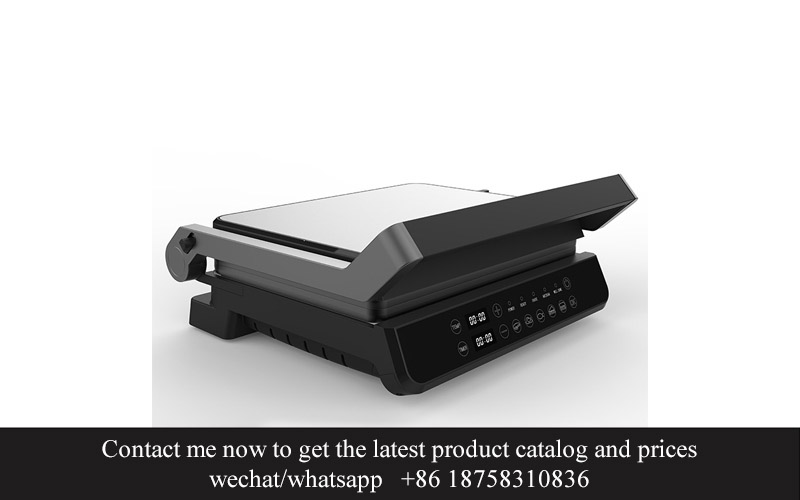Address
304 North Cardinal
St. Dorchester Center, MA 02124
Work Hours
Monday to Friday: 7AM - 7PM
Weekend: 10AM - 5PM
Address
304 North Cardinal
St. Dorchester Center, MA 02124
Work Hours
Monday to Friday: 7AM - 7PM
Weekend: 10AM - 5PM

In a world where convenience meets culinary creativity, non-stick cookware has become a staple in kitchens across Europe and North America. As consumers seek out products that are not only easy to use but also safe and eco-friendly, the demand for LFGB compliant non-stick cookware is on the rise. This article delves into the factors that influence consumer choices, the benefits of LFGB compliance, and how to navigate the market to find the perfect non-stick cookware that meets both quality standards and personal preferences.
In recent years, the kitchen appliance industry in Europe and North America has witnessed a significant surge in the popularity of non-stick cookware. This trend isn’t just a passing fad; it’s a reflection of changing consumer preferences and a growing emphasis on health and convenience.
Cooking enthusiasts and busy homemakers alike are gravitating towards non-stick pans for their ease of use and the promise of a healthier cooking experience. The non-stick surface eliminates the need for excessive oil, reducing the calorie content of meals and minimizing the risk of harmful fats and oils sticking to the pan.
The convenience factor is undeniable. With non-stick cookware, ingredients slide off the surface effortlessly, making clean-up a breeze. This is particularly appealing to those who prefer spending less time cleaning and more time enjoying their meals.
As the demand for non-stick cookware has skyrocketed, manufacturers have responded with a variety of innovative designs and coatings. Consumers are no longer limited to the traditional Teflon-coated pans; now, there’s a wide array of options, including ceramic, silicone, and various proprietary coatings.
One of the key factors driving the popularity of non-stick cookware is the health consciousness of consumers in Europe and North America. These regions have seen a rise in health issues related to diet and lifestyle, leading to a heightened awareness of the importance of cooking with healthier ingredients and methods.
Additionally, the busy lifestyle of many people in these regions has made time-efficient cooking tools a necessity. Non-stick cookware allows for quicker cooking times and easier food release, which is perfect for those who are short on time but still want to prepare delicious meals.
The environmental impact of traditional cookware is also a concern. Non-stick cookware, especially those with eco-friendly coatings, is gaining traction as consumers seek to reduce their carbon footprint. These pans are often recyclable and require less energy to produce, making them a more sustainable choice.
Moreover, the market for non-stick cookware is becoming increasingly competitive. Brands are not just focusing on the non-stick aspect but also on other features that enhance the cooking experience, such as induction compatibility, lightweight materials, and ergonomic handles.
In Europe and North America, the non-stick cookware market is also influenced by the growing trend of home cooking and baking. With more people cooking at home, there’s a higher demand for cookware that can handle a variety of cooking techniques, from sautéing to baking.
The rise of non-stick cookware is also a testament to the power of marketing and consumer influence. Social media, cooking shows, and influencers have played a significant role in promoting the benefits of non-stick cookware, leading to a surge in sales.
While non-stick cookware has its advantages, it’s not without its critics. Some consumers are wary of the potential health risks associated with certain coatings, such as PFOA and PTFE, which have been linked to various health issues. However, the industry has responded by developing safer, more sustainable alternatives that are free from these harmful substances.
As the demand for non-stick cookware continues to grow, manufacturers are investing in research and development to improve the durability and performance of these products. The goal is to create cookware that not only meets the needs of today’s consumers but also stands the test of time.
In conclusion, the rise of non-stick cookware in Europe and North America is a multifaceted trend driven by health concerns, convenience, environmental awareness, and the competitive kitchen appliance market. As consumers seek out the best products for their needs, the non-stick cookware industry is poised to continue its upward trajectory, offering a variety of options that cater to diverse preferences and lifestyles.

In the competitive world of kitchen appliances, the pursuit of quality is paramount. One of the most respected standards that manufacturers strive to meet is the LFGB (Legislation on the Materials and Articles Intended to Come into Contact with Food). This comprehensive regulation has become a benchmark for quality, ensuring that products, particularly those in the cookware industry, are safe and meet the highest standards of food contact materials.
LFGB, which stands for Lebensmittel- und Bedarfsgegenständegesetz, translates to the German Law on Materials and Articles Intended to Come into Contact with Food. It was established to regulate the safety of products that come into contact with food, ensuring that they do not leach harmful substances into the food we consume. This legislation is particularly important in Europe, where food safety is a cultural cornerstone.
One of the key aspects of LFGB compliance is the strict testing and certification process. Manufacturers must undergo rigorous assessments to prove that their products meet the stringent requirements set forth by the law. This includes testing for the presence of heavy metals, plasticizers, and other potentially harmful chemicals that could migrate into food. The thoroughness of these tests ensures that only the safest cookware reaches the consumer.
The standards set by LFGB are not just about the absence of harmful substances; they also cover the durability and performance of cookware. The non-stick coatings, for example, must be able to withstand high temperatures without degrading or releasing toxic fumes. This means that cookware with LFGB certification is not only safe but also long-lasting and reliable.
For consumers, the LFGB mark is a symbol of trust. When they see this certification on a product, they can be confident that it has passed a thorough examination and meets the highest safety standards. This is particularly reassuring for families with young children or individuals with health concerns related to food safety.
The LFGB also addresses the environmental impact of cookware. The regulation includes provisions for recycling and disposal, ensuring that products are designed with the environment in mind. This commitment to sustainability is an integral part of the LFGB standard, making it an even more attractive certification for eco-conscious consumers.
In the realm of non-stick cookware, LFGB compliance is especially critical. Non-stick coatings are designed to make cooking easier and healthier by reducing the need for oil. However, these coatings must be free from perfluorooctanoic acid (PFOA) and polytetrafluoroethylene (PTFE), which are known to be harmful. LFGB certification guarantees that these harmful substances are not present in the non-stick coatings, thus providing peace of mind to users.
The LFGB also covers the materials used in cookware, such as stainless steel, aluminum, and cast iron. These materials must meet specific criteria to ensure they do not leach into food or react with acidic ingredients. The certification process includes testing for the compatibility of these materials with food, ensuring that cookware is not only safe but also functional.
For manufacturers, achieving LFGB compliance is not an easy task. It requires a significant investment in quality control and testing facilities. However, the benefits are clear. Brands that can boast LFGB certification often enjoy a competitive edge in the market, as consumers are increasingly seeking out products that meet the highest safety and quality standards.
The LFGB standard is also dynamic, continually updated to reflect new scientific findings and emerging health concerns. This adaptability ensures that the certification remains relevant and effective, providing a reliable benchmark for quality in the ever-evolving cookware industry.
In conclusion, LFGB compliance is more than just a legal requirement; it is a commitment to safety, quality, and sustainability. For manufacturers and consumers alike, it represents a mark of excellence that can inspire confidence and trust. As the demand for safe and reliable cookware continues to grow, the LFGB standard will likely remain a cornerstone of quality in the kitchen appliance market.

In recent years, the world of non-stick cookware has seen a surge in technological advancements, transforming the way we cook and clean in the kitchen. From the initial days of Teflon to the cutting-edge innovations of today, the evolution of non-stick coating technology is a testament to human ingenuity and a relentless pursuit of perfection. Here’s a glimpse into the fascinating world of these innovations.
The Emergence of PTFEThe journey of non-stick coatings began with the introduction of Polytetrafluoroethylene (PTFE), better known by its trade name, Teflon. Developed by the chemical company DuPont in the 1930s, PTFE revolutionized cooking by providing a surface that was incredibly non-reactive, heat-resistant, and easy to clean. It quickly became a staple in kitchen appliances and cookware worldwide.
The Transition to Eco-Friendly AlternativesAs awareness of environmental concerns grew, so did the need for eco-friendlier alternatives to PTFE. Companies started to research and develop coatings that were not only non-stick but also safe for the environment. This led to the rise of alternative materials like ceramic, which is free from PTFE’s harmful fumes and is considered a safer option for health-conscious consumers.
Ceramic Coatings: A Safer ChoiceCeramic coatings have gained popularity for their durability and eco-friendliness. Unlike PTFE, which is a synthetic material, ceramics are derived from natural compounds and are generally free of toxic substances. They also offer a longer-lasting non-stick surface, reducing the need for frequent replacement. The process of applying ceramic coatings involves a chemical bond that adheres to the cookware, ensuring a robust and reliable performance.
The Introduction of Titanium CoatingsBuilding upon the success of ceramic coatings, manufacturers have started to incorporate titanium into the non-stick formula. Titanium coatings are known for their exceptional strength and heat resistance. They provide an additional layer of protection against scratching and wear, making them a favorite among professional chefs and avid home cooks alike.
Smart Non-Stick CoatingsThe latest innovation in non-stick technology involves the integration of smart materials that adapt to the cooking conditions. These coatings can change color to indicate when the cookware is at an unsafe temperature, preventing sticking and potential damage to the cookware. They also incorporate nano particles that create a surface with tiny grooves, which trap fat and moisture to enhance non-stick properties without the use of harmful chemicals.
The Use of NanotechnologyNanotechnology has played a significant role in the development of advanced non-stick coatings. By manipulating materials at an atomic level, scientists have been able to create coatings with unique properties. Nanocoatings are often more durable and provide better heat distribution than traditional non-stick coatings. They can also be applied in thinner layers, reducing the risk of wear and tear over time.
Health and Safety StandardsAs non-stick coatings continue to evolve, so do the health and safety standards. Many manufacturers are now adhering to rigorous certifications like the LFGB (German Food, Drug, and Cosmetic Products Act), ensuring that their coatings are safe for use with food. These standards dictate the acceptable levels of heavy metals and other harmful substances, giving consumers peace of mind when choosing their cookware.
Consumer Education and Product TransparencyWith the increasing sophistication of non-stick coatings, consumer education has become paramount. Manufacturers are now providing detailed information about the materials used in their cookware, allowing consumers to make informed decisions based on their personal preferences and values. This transparency has helped to build trust and foster a more educated market.
In conclusion, the evolution of non-stick coating technology has been a remarkable journey of innovation and improvement. From the early days of Teflon to the sophisticated, eco-friendly coatings of today, the non-stick cookware industry continues to push the boundaries of what is possible. As technology advances, we can expect even more groundbreaking developments that will enhance our cooking experience and contribute to a healthier, more sustainable kitchen environment.

Non-stick cookware has become a staple in kitchens across Europe and North America, and with good reason. The benefits of LFGB compliant non-stick cookware are numerous, offering both convenience and peace of mind to homeowners. Here’s a closer look at some of the key advantages:
Safety FirstOne of the primary reasons for the popularity of non-stick cookware is the safety it offers. Traditional cookware often requires high heat to prevent food from sticking, which can lead to the release of harmful chemicals into the food. LFGB compliant non-stick coatings, however, are designed to withstand high temperatures without breaking down or releasing toxic fumes. This means you can cook at lower temperatures, reducing the risk of harmful substances leaching into your meals.
Ease of CookingCooking with non-stick cookware is a breeze. The surface is so slippery that it allows food to release effortlessly, eliminating the need for excessive oil or butter. This not only makes clean-up easier but also means you can prepare healthier meals by reducing the fat content. Whether you’re flipping eggs or searing steak, the non-stick surface ensures that your food will cook evenly and stay intact.
Healthier CookingWith the ability to cook with less oil, LFGB compliant non-stick cookware promotes healthier eating habits. The reduction in fat and calories is especially beneficial for those watching their weight or managing heart health. Additionally, the even cooking that non-stick cookware provides ensures that food is thoroughly cooked and less likely to harbor harmful bacteria.
Durable and Long-LastingThe non-stick coatings used in LFGB compliant cookware are designed to be durable and long-lasting. They are more resistant to scratches and wear than older non-stick coatings, which can peel or chip over time. This means your cookware will maintain its non-stick properties for years, providing a cost-effective solution for your kitchen.
Easy CleaningCleaning up after cooking is a chore that many dread, but with LFGB compliant non-stick cookware, it’s a breeze. The non-stick surface means that food particles don’t stick, making it easier to scrape off and wash away. This can save you time and water, and it also means that your cookware will look newer for longer, as stains and discoloration are less likely to set in.
Environmentally FriendlyUsing less oil and butter in cooking not only benefits your health but also has environmental implications. By choosing LFGB compliant non-stick cookware, you’re contributing to a more sustainable lifestyle by reducing the amount of oil that goes down the drain and into waterways. It’s a small change that can have a big impact on the environment.
Cooking VersatilityLFGB compliant non-stick cookware is versatile, suitable for a wide range of cooking methods. Whether you’re sautéing, frying, or baking, the non-stick surface allows for precise control and even heat distribution. This means you can experiment with various recipes without worrying about the cookware’s performance.
Enhanced Taste and FlavorThe non-stick surface prevents food from burning or sticking, which can alter the taste and flavor of your dishes. With LFGB compliant non-stick cookware, you can enjoy the true taste of your ingredients without any unwanted aftertastes or off-putting textures.
Cookware for Every BudgetFrom budget-friendly options to high-end models, LFGB compliant non-stick cookware is available at a variety of price points. This means that everyone, regardless of their budget, can find cookware that meets their needs and preferences.
In conclusion, the benefits of LFGB compliant non-stick cookware are clear. It’s safer, healthier, easier to use, and more environmentally friendly than traditional cookware. With its versatility and durability, it’s no wonder that this type of cookware has become a favorite among home cooks in Europe and North America.

The,,。:
Cookware has become more than just a necessity; it’s a statement of style and functionality. Consumers are gravitating towards cookware that not only performs well but also complements their kitchen aesthetics.
One significant trend is the increasing preference for eco-friendly and sustainable products. With growing environmental concerns, consumers are more likely to choose cookware made from recycled materials or those that are energy-efficient, like induction cooktops.
Smart kitchen technology is on the rise, with a growing number of consumers interested in cookware that offers smart features. This includes devices that can be controlled via smartphone apps, providing recipes, and monitoring cooking times and temperatures.
There’s a noticeable shift towards healthier cooking methods. Non-stick coatings, for instance, are becoming more popular as they allow for healthier cooking with less oil. Consumers are also interested in cookware that is free from harmful chemicals like PFOA and PTFE.
The demand for versatility in cookware is skyrocketing. Consumers are looking for cookware sets that can be used on various cooking surfaces, including induction, gas, and electric ranges. This flexibility means fewer pots and pans cluttering up kitchen cabinets.
Brands that offer a wide range of sizes and shapes are also catching on, as they cater to different types of cooking and ingredients. For example, smaller pans for delicate sauces and larger skillets for stir-fries are in high demand.
Quality over quantity is a mantra that’s resonating with many consumers. Instead of buying multiple low-quality pieces, they’re opting for fewer, high-quality items that last longer and perform better.
The kitchen is no longer just a place for cooking; it’s a social hub. Cookware with unique designs and patterns is becoming more popular, as they can add a touch of personality to the kitchen space.
There’s a growing interest in ethnic and international cuisines, which has led to an increase in demand for specialized cookware. Items like woks, clay pots, and cast iron skillets are becoming more sought after as consumers explore different culinary traditions.
The rise of online shopping has had a significant impact on the cookware market. Consumers are now more likely to research and purchase cookware online, thanks to the convenience and the ability to compare prices and read reviews from other customers.
Lastly, there’s a trend towards personalized and customized cookware. Consumers are looking for products that can be tailored to their specific needs, whether it’s through custom engraving or selecting specific materials and designs.
These market trends and consumer insights paint a picture of a dynamic and evolving cookware market, where innovation and adaptability are key to staying competitive. As consumers continue to seek out the perfect balance of style, functionality, and sustainability, the cookware industry will need to keep pace with these changing preferences.

In the realm of kitchen appliances, the demand for non-stick cookware has surged, driven by convenience and health-conscious consumers. Among the myriad brands and products available, several have stood out for their commitment to quality and compliance with the stringent LFGB standards. Let’s delve into some case studies of successful LFGB compliant non-stick cookware products.
One such brand is Tefal, renowned for its innovative non-stick coatings. Their products, like the Tefal ActiFry, have gained popularity for their ability to cook with minimal oil, making them a hit among health enthusiasts. The ActiFry’s non-stick coating is LFGB compliant, ensuring that it meets the highest safety standards for food contact materials.
Another standout product is the GreenPan, which offers a range of cookware with a ceramic non-stick coating. This coating is not only non-toxic but also boasts excellent durability. The GreenPan line, including the GreenPan SearSmart Pro, has been embraced by consumers looking for a sustainable and safe cooking option. The LFGB certification reinforces the brand’s commitment to quality and consumer safety.
Cuisinart has also made waves with its non-stick cookware, such as the Cuisinart Chef’s Classic Non-Stick Cookware Set. This set is praised for its even heat distribution and non-stick performance, which is attributed to the PFOA-free, ceramic-based coating. The LFGB compliance of this product line is a testament to Cuisinart’s dedication to providing cookware that is both functional and safe for everyday use.
The All-Clad line of cookware has long been a favorite among professional chefs and home cooks alike. Their non-stick cookware, like the All-Clad D3 Non-Stick Fry Pan, features a durable non-stick coating that is free from harmful chemicals. The LFGB certification on this product ensures that it meets the rigorous standards for food safety, making it a trusted choice for those who demand the best.
When it comes to induction cookware, the Demeyere Atlantis Non-Stick Induction Cookware Set is a prime example of successful LFGB compliant non-stick cookware. This set is designed with a unique non-stick coating that is both scratch-resistant and easy to clean. The LFGB certification is a seal of approval for the product’s safety, making it a top pick for those who prefer induction cooking.
Another notable brand is Zwilling J.A. Henckels, which offers a range of non-stick cookware that is LFGB compliant. Their products, such as the Zwilling J.A. Henckels Pro non-stick skillet, are highly regarded for their non-stick performance and even heat distribution. The LFGB certification adds credibility to the brand’s promise of quality and safety.
The Calphalon non-stick cookware collection, including the Calphalon One Non-Stick Cookware Set, has also been a hit in the market. Known for its superior non-stick coating and ergonomic design, this cookware set is a favorite among those who value both performance and ease of use. The LFGB compliance of Calphalon’s products is a reflection of the brand’s commitment to providing cookware that is safe for the entire family.
In the world of bakeware, the Lodge Logic Cast Iron Bakeware with Non-Stick Coating is a standout product. This bakeware is designed to offer the convenience of non-stick cooking without the use of harmful chemicals. The LFGB certification on this product ensures that it meets the strict standards for food safety, making it a reliable choice for baking enthusiasts.
The success of these LFGB compliant non-stick cookware products can be attributed to several factors. Firstly, the use of non-toxic coatings that are free from PFOA and PFAS has become a significant selling point for health-conscious consumers. Secondly, the durability and ease of cleaning of these products have made them a practical choice for busy households. Lastly, the LFGB certification serves as a trust signal to consumers, assuring them of the product’s safety and quality.
In conclusion, the case studies of these successful LFGB compliant non-stick cookware products highlight the importance of safety, performance, and sustainability in the kitchen appliance market. As consumers continue to seek out cookware that meets their health and environmental concerns, brands that prioritize compliance with rigorous standards like LFGB are likely to remain at the forefront of the industry.

The evolution of non-stick cookware has been nothing short of remarkable. From the early days of Teflon to the latest advancements in coating technology, the future of non-stick cookware is poised to bring even more innovation and convenience to the kitchen. Here are some of the key trends and potential developments shaping the future of this essential kitchen staple.
Cookware materials are continually being refined, with manufacturers exploring new ways to enhance durability and performance. One of the most exciting developments is the integration of nanotechnology into non-stick coatings. These ultra-thin layers can provide a superior non-stick surface while remaining highly durable and scratch-resistant.
Energy efficiency is another area where advancements are being made. As consumers become more environmentally conscious and cost-aware, cookware that can reduce energy consumption will become increasingly popular. Innovations like heat-conductive coatings and improved insulation are being developed to ensure that pots and pans retain heat more effectively, thus reducing the need for prolonged cooking times.
The health and safety of consumers are paramount, and the future of non-stick cookware will likely see further improvements in material safety. Brands are already moving away from older, potentially harmful coatings like PFOA and PFAS, and are instead investing in alternatives that are free from these contaminants. This shift is not only better for the consumer but also for the environment.
Smart technology is making its way into the kitchen, and non-stick cookware is no exception. Imagine a pan that can adjust its temperature to prevent sticking and reduce cooking times. Smart cookware could be equipped with sensors that monitor cooking conditions and provide real-time feedback to the user, ensuring perfect results every time.
Sustainability is a growing concern, and the future of non-stick cookware will likely reflect this. Biodegradable and compostable materials are being researched as alternatives to traditional plastics. These eco-friendly options could be used in the handles, bases, and even the non-stick coatings themselves, reducing the environmental impact of cookware production and disposal.
Customization is another trend that’s catching on. As consumers seek out cookware that fits their unique cooking styles and preferences, brands are offering a wider range of sizes, shapes, and materials. This could include collections that cater to specific dietary needs, such as non-stick cookware designed for vegan or gluten-free cooking.
Collaborations between cookware manufacturers and culinary experts are also on the rise. These partnerships are leading to the development of cookware that not only performs well but also provides valuable insights into the art of cooking. Cookware sets may come with accompanying recipes, cooking tips, and even educational content to help improve culinary skills.
The future of non-stick cookware also includes a focus on ease of cleaning. With busy lifestyles and the desire for minimal maintenance, cookware that is easier to clean will be highly sought after. Advances in coating technology are making non-stick surfaces more resistant to stains and discoloration, making them simpler to keep looking new.
As the world becomes more globalized, non-stick cookware will also reflect cultural influences. International brands are incorporating traditional cooking techniques and materials from around the world into their product lines, offering consumers a diverse range of options that cater to various culinary traditions.
In conclusion, the future of non-stick cookware is one of continuous improvement, innovation, and adaptation to the needs and values of consumers. From health and safety to sustainability and technology, the next generation of non-stick cookware is set to revolutionize the way we cook and live.

Understanding the importance of LFGB compliance, it’s essential to navigate the vast array of non-stick cookware options with a keen eye. Here are some key factors to consider when selecting LFGB compliant non-stick cookware:
Material QualityThe material of the cookware is paramount. Opt for non-stick cookware made from high-quality aluminum or stainless steel, which offers excellent heat distribution and durability. Ensure that the base is thick enough to prevent warping and ensure even cooking.
Non-Stick CoatingThe non-stick coating is the heart of any non-stick pan. Look for coatings that are LFGB compliant, such as PTFE (Teflon), ceramic, or eco-friendly alternatives like silicone. These coatings should be free of harmful chemicals and designed to last for years without peeling or flaking.
Handle and ErgonomicsA good handle design is crucial for safety and comfort. Handles should be heat-resistant, comfortable to grip, and provide a secure hold. Consider cookware with ergonomically designed handles that are easy to maneuver in the kitchen.
Dishwasher SafetyIf you prefer hassle-free cleaning, opt for non-stick cookware that is dishwasher safe. However, keep in mind that frequent machine washing can wear down the non-stick coating over time. Always check the manufacturer’s recommendations for the best cleaning methods.
Cooking PerformanceTest the cookware’s performance by cooking a variety of dishes. A high-quality non-stick pan should distribute heat evenly, allowing you to cook without using excessive amounts of oil. The pan should also be responsive to temperature changes, preventing hot spots.
Manufacturer ReputationResearch the brand and manufacturer’s reputation. Look for companies with a strong track record in producing LFGB compliant non-stick cookware. Read customer reviews and ratings to gauge the satisfaction of other users.
Price vs. ValueConsider the price of the cookware in relation to its quality and features. While it’s tempting to go for the cheapest option, investing in a higher-quality LFGB compliant non-stick pan can save you money in the long run by providing durability and performance.
Environmental ImpactBe mindful of the environmental impact of your cookware choice. Some brands offer non-stick cookware made from sustainable materials or are committed to reducing their carbon footprint. This not only benefits the environment but can also make your cookware a more ethical purchase.
Safety FeaturesEnsure that the non-stick cookware you choose includes safety features like heat-resistant handles and a cool-to-the-touch surface. These features are particularly important if you have children or pets in the home.
Warranty and Customer ServiceA good manufacturer will stand behind their product with a warranty and excellent customer service. Check the warranty period and what it covers. This can provide peace of mind and protection should any issues arise with your non-stick cookware.
By carefully considering these factors, you can select LFGB compliant non-stick cookware that meets your culinary needs, safety standards, and personal preferences. Remember, the right cookware can enhance your cooking experience and make meal preparation more enjoyable and efficient.